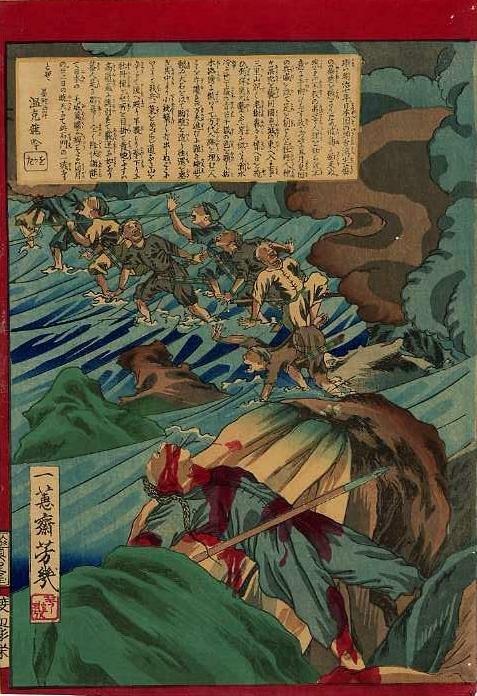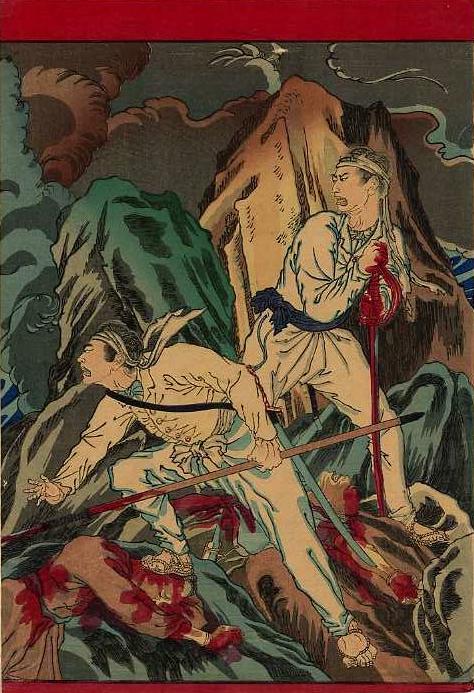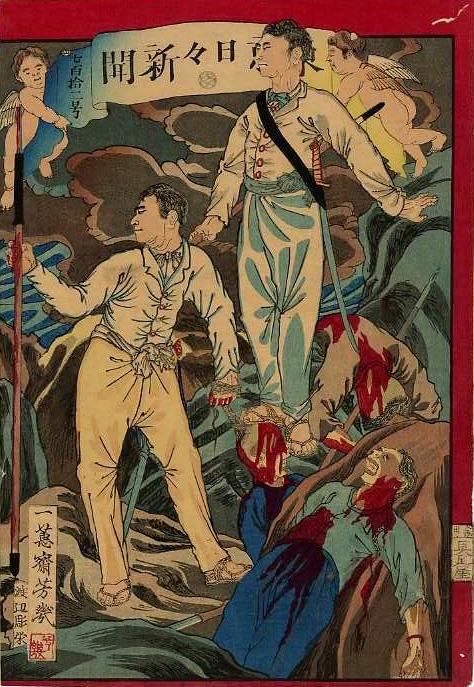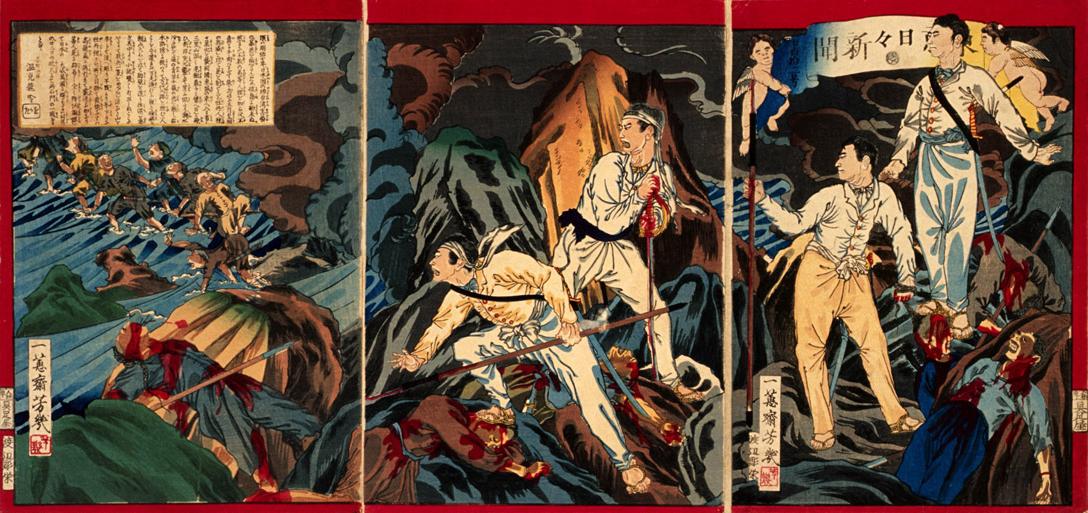Tokyo nichinichi shinbun Story in briefIn 1874, the army of Japan voyaged to Taiwan to punish its raw savages for their atrocities. In May, military forces of the Imperial Nation attacked the nest holes of the Bootan race. The mountains were deep, the forests were thick, and the terrain was rugged, but victory came after a fierce battle at the Stonegate pass into the Botan mountains at dawn on the 22nd of the month, as shown in this triptych. (WW) An unnumbered Battle of Stonegate triptych shows a bit more gruesome aspect of the attack. See Battle at Stonegate 2: Trophy heads. |
||||||||||||
Commentary
Thanks to the battle at Stonegate (石門 J. Sekimon, C. Shihmen, Shímén), the place became well-known and is now a popular tourist spot with a number of historical monuments and a museum.
Raw and cooked savages
army of Japan reflects "Nipponkoku no ikusa" (日本国の師).
raw savages referred to the aboriginals who had not been brought under the control of Chinese settlements on Taiwan -- literally "raw savages" (生審 seiban) -- in contrast with Sinified "cooked savages" (熟審 jukuban). See Meiji Taiheiki: Meiji Great Peace Chronicle for further representations of these two classes of aboriginals.
"no" and "ga"
Affiliation markers "no" (の) and "ga" (が) are thought to have been used to show differences of respect for things being contrasted in the same context -- "no" showing more respect than "ga". This appears to be the case here.
"no" is used in 皇国の兵威 (Kuwaukoku no heiwi, Koōkoku no heii) meaning military forces of the Imperial Nation.
"ga" is used in 牡丹人種が巣穴 (Bootan jinshu ga sōketsu") meaning nest holes of the Botan race.
Both noun phrases are followed by object marker "w/o" (を).
"race" and "species"
"Bootan reflects the katakana reading provided for 牡丹 (ホータン). See next item for further details. Later in the story, "Bootan race" is expressed as "Bootan species" (牡丹種 Bootan shu).
"nest holes" and "grave holes"
The graphs used to represent "nest holes" (巣穴 sōketsu) could be read "suana" in Japanese. Either would imply that the raw savages live like animals. It is tempting, but probably not justified, to imagine that the Sino-Japanese reading was intended to invite some readers or listeners to think of "grave hole" (葬穴). In contemporary orthography, the later would have been written "sauketsu" though most people would probably have read it "sōketsu" -- the same as it is written and pronounced today. But the choice of reading is probably guided by the writer's desire to affect a 7/5 moraic structure on the phrase.
Name of "Bootang Tribes"
An interesting linguistic feature in the text of the "Battle at Rockgate" nishikie triptych is a reference to the Paiwan as "Bootanshu" (Bootan species/tribes). "Bootan" would generally be prounounced "Bootang" in Japanese, and "Bootang Tribes" is the name given on an 1869 map of Taiwan made by Charles Le Gendre, the American consul who helped train Japan's army for its Taiwan mission.
1868 -- Area and inhabitrants unnamed on a map called "Ile de Formose avec indication de l'emplacement des tribus aboriges" [Isle of Formosa indicating the location of Aborigine tribes], published by Guerin & Bernard, 1868.
1869 -- Bootang Tribes on map compiled by General Charles W. Le Gendre, U.S. Consul, Amoy & Formosa, called "Formosa island and the Pescadores, China," in a report on the commercial relations of the United States and foreign nations, for the year ending September 30, 1869. Washington: Government Printing Office, 1871, facing page 108, (4:1-21).
1874 -- Butang on "Map of Formosa" by E.G. Ravenstein, in an article on "Formosa" in The Geographical Magazine 1, 1874, pages 292-293.
1875 -- Bootang Tribes on "Island of Formosa" map by B.W. Bax, in The eastern seas: Being a narrative of the voyage of H.M.S. 'Dwarf' in China, Japan, and Formosa. London: John Murray, 1875, facing page 37.
1877 -- Tribus Boutang on map of unknown origin showing Formosa with Catholic mission stations marked on it, in Les Missions Catholiques No. 427 (10 Aout 1877), page 387.
1877 -- B.=Butang. on map by Paul Ibis, "Skizze von FormosaDscala 1:3,000,000" [Sketch of Taiwan], in "Auf Formosa: Ethnographische Wanderungen," Globus 31, 1877, page 150.
These and many other maps can be viewed at the Maps of Formosa page on Reed College's digital library of Formosan texts and images.



